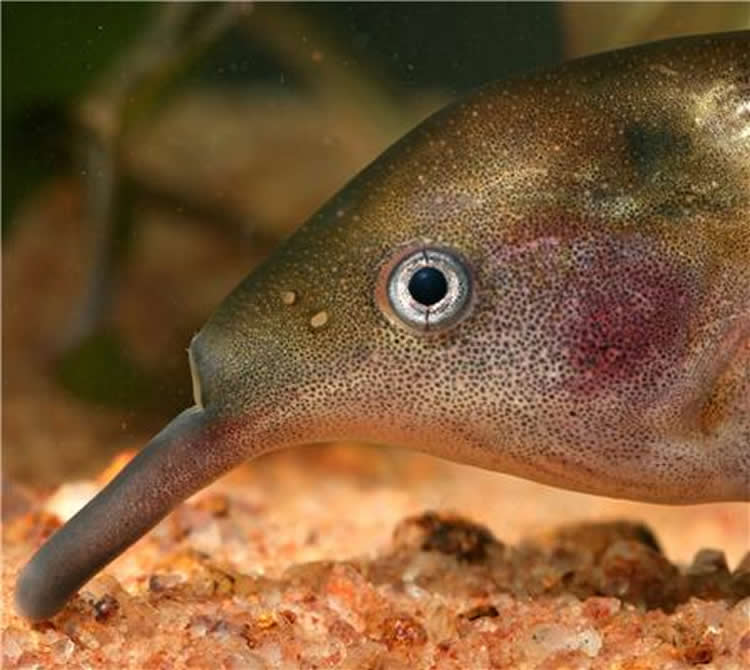Summary: A new study reports the elephantnose fish utilizes both its eyes and electrolocation to expore objects in its environment.
Source: University of Bonn.
The elephantnose fish explores objects in its surroundings by using its eyes or its electrical sense – sometimes both together. Zoologists at the University of Bonn and a colleague from Oxford have now found out how complex the processing of these sensory impressions is. With its tiny brain, the fish achieves performance comparable to that of humans or mammals. The advance results have been published online in the “Proceedings of the National Academy of Sciences” (PNAS).
The elephantnose fish (Gnathonemus petersii) is widespread in the flowing waters of West Africa and hunts insect larva at dawn and dusk. It is helped by an electrical organ in its tail, which emits electrical impulses. The skin contains numerous sensor organs that perceive objects in the water by means of the changed electrical field. “This is a case of active electrolocation, in principle the same as the active echolocation of bats, which use ultrasound to perceive a three-dimensional image of their environment”, says Professor Dr. Gerhard von der Emde at the Institute of Zoology at the University of Bonn. Furthermore, the elephantnose fish can also orient using its eyes.
Professor von der Emde, along with his doctoral candidate Sarah Schumacher and Dr. Theresa Burt de Perera of Oxford University, have now investigated how the unusual fish processes the information from the various sensory channels. Ms. Schumacher summarizes the results: “The animals normally use both senses. If necessary, for example because one of the two senses provides no information or the information of the two senses differs greatly, however, the fish can switch back and forth between their visual and electrical senses”. The scientists were surprised by the manner in which the fish use these two senses to get the best perception of their environment: When the animals became familiar with an object in the aquarium, for example with the visual sense, they were also able to recognize it again using the electrical sense, although they had never perceived it electrically before.
Fish give precedence to the most reliable sensory information
In addition, the fish demonstrated a previously unexpected ability: Their brain gave more weight to the information it thought was more reliable. When the two senses delivered different information in the close range of up to two centimeters, the fish trusted only the electrical information and were then “blind” to the visual stimuli. In contrast, for more distant objects, the animals relied above all on their eyes. They perceived the environment best by using their visual and electrical senses in combination. “A transfer between the different senses was previously known only for certain highly developed mammals, such as monkeys, dolphins, rats, and humans”, says Professor von der Emde. An example: In a dark, unfamiliar apartment, people feel their way forward to avoid stumbling. When the light goes on, the obstacles felt are recognized by the eye without any problem. Mammals process such information with their cerebral cortex. The elephantnose fish, however, has just a relatively small brain and no cerebral cortex at all – but nevertheless switches back and forth between the senses.
Clever experimental setup
The scientists came up with a very clever test setup: The elephantnose fish was in an aquarium. Separated from it were two different chambers, between which the animal could choose. Behind openings to the chambers there were differently shaped objects: a sphere or a cuboid. The fish learned to steer toward one of these objects by being rewarded with insect larvae. Subsequently, it searched for this object again, to obtain the reward again.

When does the fish use a particular sense? In order to answer this question, the researchers repeated the experiments in absolute darkness. Now the fish could rely only on its electrical sense. As shown by images taken with an infrared camera, it was able to recognize the object only at short distances. With the light on the fish was most successful, because it was able to use its eyes and the electrical sense for the different distances. In order to find out when the fish used its eyes alone, the researchers made the objects invisible to the electrical sense. Now, the sphere and cuboid to be discriminated had the same electrical characteristics as the water.
Many repetitions of the individual experiments were necessary in order to apply statistical analyses to reach conclusions about the sensory processing of the elephantnose fish. The scientists worked with a total of ten animals, working more or less in shifts. “The behavior of the different individuals was nearly identical”, says Professor von der Emde. For that reason the scientists are certain that this enormous sensory performance is achieved not only by a particulary talented specimen but by all elephantnose fish.
Source: University of Bonn
Image Source: This NeuroscienceNews.com image is credited to Timo Moritz.
Original Research: Abstract for “Cross-modal object recognition and dynamic weighting of sensory inputs in a fish” by Sarah Schumacher, Theresa Burt de Perera, Johanna Thenert, and Gerhard von der Emde in PNAS. Published online June 16 2016 doi:10.1073/pnas.1603120113
[cbtabs][cbtab title=”MLA”]University of Bonn. “Small Brain – Astounding Performance.” NeuroscienceNews. NeuroscienceNews, 24 June 2016.
<https://neurosciencenews.com/elephant-nose-fish-brain-4558/>.[/cbtab][cbtab title=”APA”]University of Bonn. (2016, June 24). Small Brain – Astounding Performance. NeuroscienceNew. Retrieved June 24, 2016 from https://neurosciencenews.com/elephant-nose-fish-brain-4558/[/cbtab][cbtab title=”Chicago”]University of Bonn. “Small Brain – Astounding Performance.” https://neurosciencenews.com/elephant-nose-fish-brain-4558/ (accessed June 24, 2016).[/cbtab][/cbtabs]
Abstract
Cross-modal object recognition and dynamic weighting of sensory inputs in a fish
Most animals use multiple sensory modalities to obtain information about objects in their environment. There is a clear adaptive advantage to being able to recognize objects cross-modally and spontaneously (without prior training with the sense being tested) as this increases the flexibility of a multisensory system, allowing an animal to perceive its world more accurately and react to environmental changes more rapidly. So far, spontaneous cross-modal object recognition has only been shown in a few mammalian species, raising the question as to whether such a high-level function may be associated with complex mammalian brain structures, and therefore absent in animals lacking a cerebral cortex. Here we use an object-discrimination paradigm based on operant conditioning to show, for the first time to our knowledge, that a nonmammalian vertebrate, the weakly electric fish Gnathonemus petersii, is capable of performing spontaneous cross-modal object recognition and that the sensory inputs are weighted dynamically during this task. We found that fish trained to discriminate between two objects with either vision or the active electric sense, were subsequently able to accomplish the task using only the untrained sense. Furthermore we show that cross-modal object recognition is influenced by a dynamic weighting of the sensory inputs. The fish weight object-related sensory inputs according to their reliability, to minimize uncertainty and to enable an optimal integration of the senses. Our results show that spontaneous cross-modal object recognition and dynamic weighting of sensory inputs are present in a nonmammalian vertebrate.
“Cross-modal object recognition and dynamic weighting of sensory inputs in a fish” by Sarah Schumacher, Theresa Burt de Perera, Johanna Thenert, and Gerhard von der Emde in PNAS. Published online June 16 2016 doi:10.1073/pnas.1603120113






